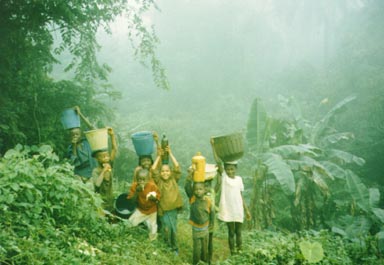Culture in Pictures: Equatorial Guinea
This series, started by Renaerules, is designed to share the history and culture of Spanish-speaking countries through picture. Each person should include a description of the photo they provide and since this thread is not an excersise I think it would be suitable to post in either Spanish or English and let the readers feel free to make corrections in the comment section.
This week we visit Equatorial Guinea at the request of our friend Fidalgo. A bit of a jump from Central America but we will return. The only Spanish speaking country on the continent of Africa is made up of six major tribes; Fang, Bubi, Ndowes, Annobón, Bisios, Fernandinos. The country itself is made up of the mainland sandwiched between Cameroon to the North and Gabon to the South. Offshore are five islands; Annobón,Corisco, Small Elobey, Great Elobey and Bioko the latter being the home of the capital of Malabo. In 1472, the Portuguese navigator Fernão do Pó was the first European to visit the island ( I can now understand Fidalgo's interest ) and it was then named Fernando Po. In 1474, that island and Annobón were colonized by Portugal. In 1778 the islands and the mainland, which was called Rio Muni, were ceded to Spain and became know as Territorios Españoles del Golfo de Guinea Ecuatorial. The territories were united as Spanish Guinea in 1926 and in 1968 gained their independence from Spain. Tribal art in masks and woodcarvings dominate the culture and it is said that Pablo Picasso was greatly influenced by it. I am hoping someone can find some examples as I've had little luck.
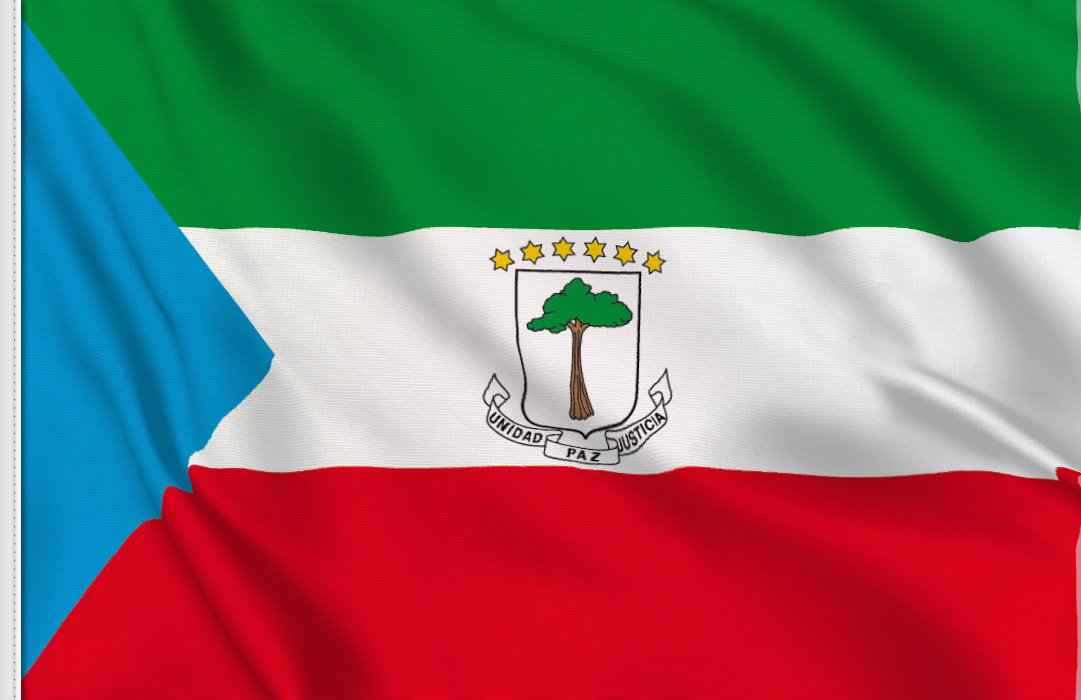
 Children of the Fang tribe.
Children of the Fang tribe.
16 Answers

Las Hijas del Sol is a famous Equatoguinean duo from Malabo.
Here is their profile on my space Hijas del Sol -myspace
And some songs of them
Hoy No Lloraré, El Viajero, Yo Tengo La Luz
Fifi La Mirey is another artist. Here is one of her works Ewo Wo
And some other songs Marie Chantal by Mayor Copery, Congosa by Sandra Star, Falsa Moneda by Concha Buika, Diputados by Coro Antorcha De Añisok, La vida es tranki by Yuma, etc.
Wow, I can't believe someone mentioned this country! My brother just spent several months working there on a Presidential Library in Mongobo. They did not make much progress due to the third world nature of the country. But he did enjoy making friends with the locals. He left because they wanted him to be a slave driver for the locals. The people there spoke Fang. I was trying to help him by teaching him some Spanish but it was not useful to him.
Children play a skipping game in front of cathedral built during colonial times in Malabo, Equatorial Guinea, August 25, 2002.

People Nationality: Noun--Equatorial Guinean(s), Equatoguinean(s) Adjective--Equatorial Guinean, Equatoguinean. Population (July 2009 est.): 633,441. Annual growth rate (2009 est.): 2.703%; (1975-2002): 2.8%. Ethnic groups: The Fang ethnic group of the mainland constitutes the great majority of the population and dominates political life and business. The Bubi group comprises about 50,000 people living mainly in Bioko Island. The Annobonese on the island of Annobon are estimated at about 3,000 in number. The other three ethnic groups are found on the coast of Rio Muni and include the Ndowe and Kombe (about 3,000 each) and the Bujebas (about 2,000). The pygmy populations have long been integrated into the dominant Bantu-speaking cultures. Europeans number around 2,000, primarily Spanish and French. There is a thriving Lebanese community, other Arabs (primarily Egyptians), a large number of Filipinos, and a rapidly expanding Chinese presence. Languages: Official--Spanish, French; other--pidgin English, Fang, Bubi, Ibo. Religion: Nominally Christian and predominantly Roman Catholic; pagan practices. Education: Primary school compulsory for ages 6-12. Attendance (2007 est.)--90%. Adult literacy (2008 est.)--87%. Health (2009 est.): Life expectancy--61.61 years. Infant mortality rate--81.58/1,000.
Gran Caldera Volcánica de Luba, Bioko Sur Province
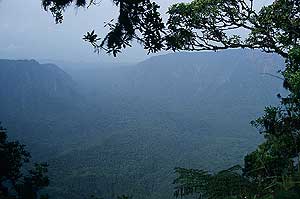
Cascadas Iladyi, Moka, Bioko Sur Province

Playa de Ureka, Bioko Sur Province
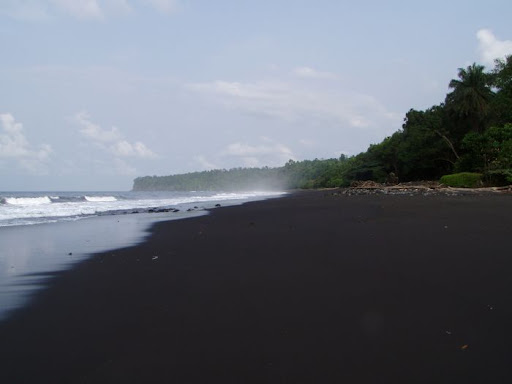
Corisco (claimed by Gabon)
Islas Elobey
Rio Benito

Monte Alen

Lago de Biaó

Annobón

Pico Basilé, Moka

Indígenas balengues en el "balele"
Bailarín Pamue
Bailarina Pamue
Balele Pamue
Traje Típico Fernando Poo
Bailarin "Yanque" en Santa Isabel
Mujer Bubi en traje de fiesta en Fernando Póo
Source: http://jcmcrhp.net/tarjepos2.htm. More images: http://bioko.net/postal/thumbnails.php?album=14&page=4

I hate that the children have to live in the poverty that they live in, but they seem so happy. There's a saying that says: "The rich are really poor, and the poor are really rich." ![]()
Thank you so much Fidalgo it is very thoughtful of you , I was not aware of the existence of this beautiful place , but I do recall that there was many years ago a Spanish Morocco, is that right or not ?
A closer look....
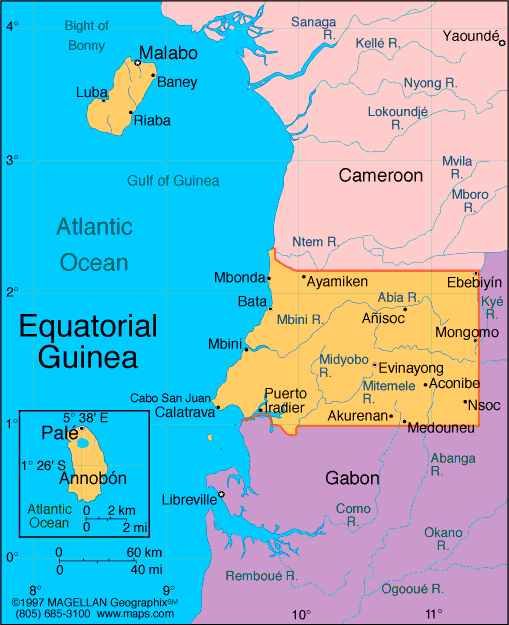

The Bubi people, also known as Voove, Bobes, Boobes, Boobees, Adeejahs, Adijas, Ediyas, Eris, Fernando Poans, Fernandians, and Bantu Speaking Bubi, are an African ethnic group, members of the Bantu group, who are indigenous to Bioko Island, Equatorial Guinea. (Source: Wikipedia)
I did a project on this country in my high school Spanish class. The poverty and corruption are deplorable. It should be, per capita, a very wealthy nation because of oil deposits off its coast, but the upper crust has succeeded in siphoning away any life-saving funds to finance their morally repugnant perversions.
"Red-eared guenons (with red tails) and Preuss' guenons for sale in bushmeat market Malabo, Equatorial Guinea."
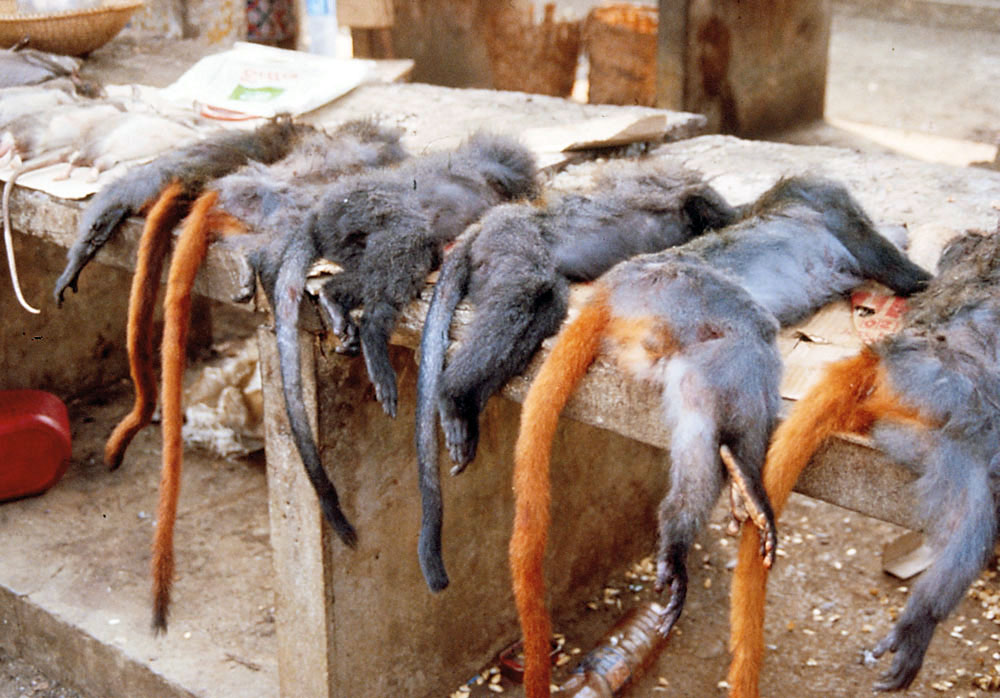
TRIBAL AFRICAN ART
FANG Gabon, Cameroon and Equatorial Guinea
The people that are called “Fang” in the geographic or ethnographic literature number 800,000 and constitute a vast mosaic of village communities, established in a large zone of Atlantic equatorial Africa comprising Cameroon, continental equatorial Guinea and nearly the whole north of Gabon, on the right bank of the Ogowe River. Historically the Fang were itinerant, and it is relatively recently that they have settled into this broad area. The migratory existence of the Fang prohibited the creation of ancestral shrines at gravesites. Instead, the remains of the important dead, in the form of the skull and other bones, were carried from place to place in a cylindrical bark box. The great rain forest region where the Fang settled is a plateau of middle altitude, cut by innumerable waters with falls and rapids rendering navigation for the most part impossible, and with a climate typically equatorial. Fang are principally hunters but also agriculturists. Their social structure is based on a clan, a group of individuals with a common ancestor, and on the family.
Fang Sculpture:
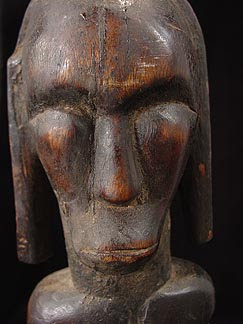
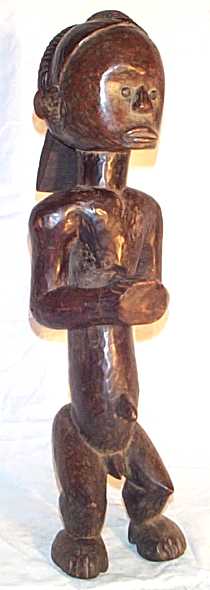
The ensemble of Fang peoples practice a cult devoted to ancestor lineages, the bieri, whose aim is to both protect themselves from the deceased and to recruit their aid in matters of daily life. This familial cult does not monopolize the Fang’s religious universe, for it coexists with other beliefs and rituals of a more collective character. It is the bieri, or ancestor sculpture, which has most obviously given rise to the making of remarkable wooden sculpture. The statuary of the Fang can be classified into three main groups: heads on long necks, half-figures and full figures, standing or seated. Carved with great simplicity, at the same time they exhibit a high degree of sophistication in the coordination of bulbous forms. The neck is often a massive cylindrical form. The arms have various positions: hands clasped in front of the body (sometimes holding an object); held in front of the chest or attached to it; hands resting on the knees in the seated figures. The navel is often exaggerated into a cylindrical form. Legs are short, stunted. Usually there is a domed, wide forehead and the eyebrows often form arcs with the nose. The eyes are often made of metal roundlets. The bieri would be consulted when the village was to change location, when a new crop was planted, during a palaver, or before going hunting, fishing, or to war. But once separated from the reliquary chest, the sculpted object would lose its sacred value and could be destroyed. The ritual consisted of prayers, libations, and sacrifices offered to the ancestor, whose scull would be rubbed with powder and paint each time. With its large head, long body, and short extremities, the Fang bieri had the proportion of a newborn, thus emphasizing the group’s continuity with its ancestor and with the three classes of the society: the “not-yet-born,” the living, and the dead. The relics were essentially skull fragments, or sometimes complete skulls, jawbones, teeth and small bones. The bieri also served for therapeutic rituals and, above all, for the initiation of young males during the great so festival.
The Fang used masks in their secret societies. The ngil (gorilla) masks were worn by members of a male society of the same name during the initiation of new members and the persecution of wrong-doers. Masqueraders, clad in raffia costumes and attended by helpers, would materialize in the village after dark, illuminated by flickering torchlight. Fang masks, such as those worn by itinerant troubadours and for hunting and punishing sorcerers, are painted white with facial features outlined in black. Typical are large, elongated masks covered with kaolin and featuring a face that was usually heart-shaped with a long, fine nose. Apparently it has been linked with the dead and ancestors, since white is their color. The ngontang dance society also used white masks, sometimes in the form of a four-sided helmet-mask with bulging forehead and eyebrows in heart-shaped arcs. The ngontang mask symbolizes a ‘young white girl’. The so, or red antelope was connected with an initiation that lasted several months; these masks sport long horns.
Fang Mask:

Musical instruments – like the harp, its ends sculpted into lovely figurines – allowed communication with the hereafter. Blacksmiths bellows, many quite beautiful, were sculpted in the shape of figures; there are also small metal disks featuring heads, called “passport-masks”, the Fang attached these to their arms.
Special spoons were carved and used to administer magically sustaining nourishment as part of traditional initiation rites. An individual man’s spoon was a preciously guarded possession that was carried on his person in a shoulder bag when he traveled and was placed on his tomb when he passed away.
I know this isn't a picture, but I am a big "map" person. For some strange reason, I have to see where each country is located in relation to the rest of the world. Thank you for recommending this Fidalgo. I am embarrassed to say that I had no idea that there was a Spanish speaking country on the continent of Africa. ![]()
![]()
When looking at the whole map of Africa, Equatorial Guinea is an extremely small country.

Please accept my apologies, this is supposed to be a photo based series but it seems impossible to grab any good pics of the culture of this country. I was, however, able to find a linkto some very interesting pictures. .
My brother lived there for a year, working on some sort of construction thing on an American base. Really ironic since I also recently discovered a really good film about the country. I recommend watching it, if you're interested in E.G.! It's called "Lejos de Africa," or it might also go under the title "Isla Negra" or "Black Island." It's pretty risque in parts, but the story gives an interesting view of the colonization by Spain, as well as the culture, issues of racism, and it's entirely in Spanish!!!
